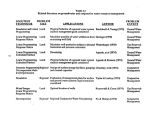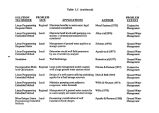| OCR Text |
Show model. The response is represented in terms of drawdowns of piezometric head at locations of interest, and in terms of abstractions of flow across boundaries of interest. A finite difference or finite element discretization of the groundwater flow equations may be used to perform the simulations necessary for the determination of the unit response matrices. These unit response matrices are used to define relationships of interest for the optimization model. The optimization model is then formulated to determine the optimal value of a management objective, subject to constraints on drawdown, water rights maintenance, groundwater quality control and demand satisfaction. The unit response formulation allows the decomposition of a potentially large aquifer simulation problem from the management problem. The aquifer may be simulated at the desired level of detail and complexity, while the management model only needs to be cognizant of the relationships between pumping and drawdown or flow at selected points. A significant reduction results in the mathematical size and complexity of the management problems to be solved. As an example consider that it is desirable to perform simulations with a very fine finite difference grid ( e. g., 100 rows by 100 columns). Where the embedding approach is used for model formulation, the number of decision variables in the optimization model would include the heads at each node of the grid for each simulation time step, in addition to the pumping rates at each well site for each time period of interest. From accuracy requirements, the time step desirable for simulation purposes may be much smaller than that desired for management. As an example consider a 10 year planning horizon, with decisions on annual pumpage at 50 well locations, and a simulation time step of 1 month. The embedding approach leads to more than 1.2 million decision variables. This is extremely large even if the type of mathematical decomposition schemes suggested by Wanakule et aL ( 1985) are used for solving the optimization problem. By comparison, the response matrix approach would lead to only 500 decision variables. Decoupling the management and simulation problems thus is almost a necessity for solving practical, large scale aquifer system management problems. 3.2.2 Aquifer Simulation and Response Matrix Generation The general equation for transient groundwater flow in an aquifer may be written as ±£ Qw 5 ( x - x w , y - y w ) - s J ( 3.1) WEW where Kx and Kv are the principal components of the hydraulic conductivity tensor along the x and y coordinates; p is the saturated thickness of the aquifer; h is the hydraulic head in the aquifer; S is the storage coefficient; F( x, y, t) is the volumetric flux per unit area representing sources or sinks of water; Qw is the pumping/ recharging rate for well w, located at ( xw, yw); 5( x- xw, y- yw) is a Dirac delta function; W is the total number of wells; Ka is a leakage coefficient; Ha is the head across a leakage boundary, and t is time. Analytical solutions of this partial differential equation for an anisotropic, heterogeneous aquifer with complex boundary conditions are not readily forthcoming. Numerical procedures such as the finite difference and the finite element method are used for its solution. The reader is referred to Wang and Anderson ( 1984) for a discussion of these techniques. Numerical methods entail the discretization of the aquifer domain into a 43 |











































































































































































































